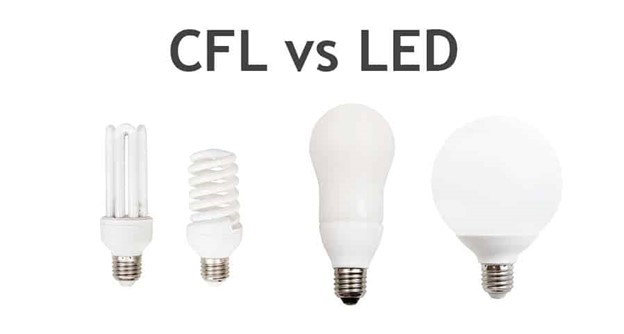Daylighting Controls & Daylight Savings: Optimizing Natural Light Through the…
Studies have shown that natural lighting has proven to improve workplaces by helping employees be more…

Energy efficiency has long been a concern for consumers. Our reliance on artificial lighting has made particularly true when considering the type of lamp you wish to use. From illuminating parking lots at night to providing ample interior lighting for businesses and residences – the right lamp (light bulb) makes a substantial difference in more ways than one. Below, our experts here at Action Services Group help to define both the CFL and LED, as well as provide a synopsis of several factors you should consider when comparing CFL vs. LED.
Years ago, the standard light bulb was made of a tungsten filament and inert gas surrounded by a glass enclosure. Known as an incandescent light bulb, a metal stem at the base of the glass structure allows an electrical current to trigger the filament and provide lighting. In 2014, however, incandescent bulbs over 40 watts were discontinued. That is where the Compact Florescent Lamp (CFL) and Light Emitting Diode (LED) lamps come in. Both are considered to be energy efficient and highly effective. However, some major differences should be considered when looking to invest in quality lighting. Before we get to that, however, it is important that you understand the difference in lamp construction when comparing CFL vs. LED.
Both CFL and LED lights are known for their brightness. However, when it comes to comparing CFL brightness vs. LED sources – experts agree that LED lamp performance exceeds that of the CFL. If you have ever used a CFL light, you will notice that it takes time for these lamps to become fully illuminated. That is because it takes roughly 30 seconds to 3 minutes for the electrical current supplied to the lamp to fully heat the phosphor coating and reach maximum illumination. By comparison, an LED will reach maximum illumination immediately. That being said, both lamps often come with “lumens,” in addition to or in place of wattages. This can be confusing as most of us are used to buying light bulbs based on wattages. You may find yourself asking what these lumens mean to you and how they translate to your previous wattage search.
Because of the energy efficiency of both CFL and LEDs, manufacturers have switched to listing lumens. Lumens provide you with a specific brightness level; wattages, however, define the energy consumption of each bulb. Nevertheless, what does it mean to you? While some lights will exceed 1600 lumens, the below standards are the most common lumens/wattage translations used:
If you are researching a new LED lighting solution for your organization, having a firm understanding of a lumen and luminous efficacy is a necessity for choosing the right solution for your company. We suggest reading Understanding Luminous Efficacy. Bonus, it’s our third most-read blog.
Both CFLs and LED lamps consume less energy than incandescent lights do. However, when it comes to CFL vs. LED energy savings, the LED is the clear winner. It is a fact: CFLs use 25% to 35% less energy than their incandescent predecessor. However, 80% of the energy they do use is released as heat into the environment. LEDs, on the other hand, use 75% less energy than an incandescent light bulb. Because of their construction, LEDs release little to no energy as heat; this means that the energy consumed by an LED is used much more efficiently than both the incandescent and CFL lamps. But if you are buying based on lumens, what are the energy consumption impacts? Let’s take a look.
Both CFL and LED light lamps will last longer than the incandescent model. When it comes to maintaining a CFL vs. LED lamp, however, experts again agree that you will likely need to replace the CFL model more frequently. In fact, the typical CFL has a lifespan of roughly 10 years. By comparison, an LED is expected to last at least 15 years, with some models exceeding 25 years. At roughly 1.5 (or more!) times the lifespan of a CFL, the LED will need to be replaced far less often. In addition to this, because LEDs use solid-state technology, they are much less susceptible to damages caused by vibrations or falls. This means accidentally bumping your lamp, or sudden vibrations are far less likely to damage the lighting elements within the LED, leading it to be replaced due to damages less often than you would a CFL. This saves you money on maintenance costs and helps reduce your overall cost impacts over time.
At the end of the day though, most people want to know what are the true CFL vs. LED cost impacts. To understand this, however, let us take a look at the costs of the four most common lumen ratings we have been comparing. Below, we list the annual cost of operating an individual light based on the average national energy costs.
From the above, the cost savings becomes readily apparent, especially at the lower lumen level. Here is a bit more on CFL vs. LED cost comparison from energy.gov.
Based on brightness, energy, maintenance, and cost comparisons above, the LED clearly exceeds the overall value of the CFL. If you have questions about what LED lighting will work best for you, contact Action Services Group today at 610-558-9773, email [email protected] or schedule a call